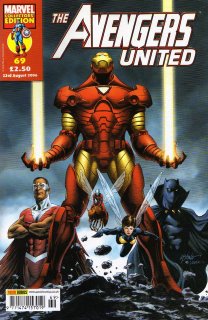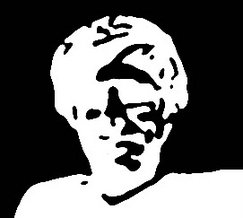Stripping Down #6
 Ultimate Spider-Man & X-Men #58 (Panini UK)
Ultimate Spider-Man & X-Men #58 (Panini UK)“Hobgoblin” by Brian Michael Bendis & Mark Bagley (Ultimate Spider-Man #77)
“Magnetic North” by Brian K. Vaughan & Stuart Immonen (Ultimate X-Men #63)
As Comics International readers may be aware, I have mixed feelings about this comic: on the one hand, I generally fail to find fault with Ultimate X-Men; on the other, my reviews of Ultimate Spider-Man tend to be unremittingly critical. To get this out of the way, my main gripes with the latter are:
i) The reimagining of Spider-Man as a comic strip counterpart of teen TV soaps like Dawson’s Creek and The O.C.;
ii) Bendis’ admittedly skilful turn with dialogue, in particular ‘talking heads’ sequences, often being at the expense of pace and action;
iii) The limited development of characters, with an almost exclusive focus on (yawn) Peter and MJ’s relationship, which seems criminal given the potentially rich supporting cast;
iv) Mark Bagley’s pedestrian art, especially in failing to employ facial expressions to convey the emotional rollercoaster of Bendis’ writing.
Taking point iv), Bagley, to his credit, is an ace at meeting monthly deadlines, a seemingly all-too-rare quality these days. I also accept that I’ve much maligned him, both in comic book letters columns and the aforementioned CI reviews pages. Okay, the latter’s 60-word review limit does mean that constructive criticism often makes way for snappy put downs and, worse, means that I’ve rarely if ever acknowledged anything that Bagley’s done well. Time to redress the balance somewhat, then: Mark Bagley’s redesign of The Hobgoblin is stunning. Something of a cross between DC’s Etrigan and forgotten Marvel character The Gargoyle, Ultimate Hobgoblin not only looks like a scary mutha, but Bagley also manages to suggest the inner torment of Harry Osborn, the character unwittingly transformed into this monster. Visually, the exchanges between Spider-Man and Hobgoblin are thrilling, moving and downright unpredictable. How ironic that Bagley’s most emotive work features characters who are literally or metaphorically hiding behind masks. Where Bagley struggles is in transferring the emotion to more human moments, notably the awkward reunion between Peter and Mary Jane at the story’s climax. The problem is that Bagley’s characters are often barely distinguishable, particularly in extreme close-up. Given Bendis’ predilection for ‘talking heads’, and at times silent exchanges, this can result in my being unable to tell Peter and MJ apart! However, return to the Spider-Man / Hobgoblin scene and the proof is there that Bagley is capable of much more expressive work. Unfortunately, Bendis’ writing doesn’t quite hit the mark either: after five issues’ build up, the climax is strangely underwhelming. I was reminded of a similar storyline in The Amazing Spider-Man #233-236, where C-list villain The Tarantula is transformed into his namesake after a failed attempt to acquire the spider-powers of his foe. Despite the victim being a previously two-dimensional villain - rather than in this case Peter Parker’s best friend – writer Roger Stern invested The Tarantula with a depth that allowed me to empathise with the character’s inevitable and plausible end. After reading this issue, Bendis has unfortunately left me with the feeling that The Hobgoblin has provided (a) a trade paperback fulfilling storyline and (b) a stock ‘classic’ character to unearth when sales on Ultimate Spider-Man start to dip. My only other experience of Brian Michael Bendis’ writing - outside of a disappointing guest slot on Ultimate X-Men - is Alias, which I enjoyed immensely. I’ll soon be able to form an opinion his work on The Avengers, but I’m hoping that it won’t continually leave me cold, like Ultimate Spider-Man. Thank goodness then for Ultimate X-Men, which seems to have kept true to it’s principle of reinventing and challenging readers’ preconceptions regarding long-established characters, whilst remembering to tell a bloody good story every four weeks. Writer Brian K. Vaughan is on a par with Mark Millar’s memorable earlier work on this series, developing characters whose relationships to one another grow, fracture or break but always seem convincing. Current storyline Magnetic North presents a truly dangerous Magneto. Inspired by the X-movie trilogy, the character is currently incarcerated in a suspended plastic cell, seemingly beyond the range of his mutant abilities. Yet, a sequence of events have led to the similarly powered Polaris being imprisoned with Magneto and it’s plain that this all part of his plan. There’s an obvious metaphor in Magneto’s chess set (his sole possession), his games mirroring the actions of his free agents. Magneto’s portrayal as a strategist means that Cyclops and Havok, brothers and Polaris’ former/current loves, are drawn into conflict, even though Professor X is aware that he and his team are being manipulated. Vaughan’s characterisation is top notch, from Cyclops and Havok’s passionate sibling rivalry, to Polaris’ torment over her inadvertent slaughter of humans, to Magneto’s cold rationalising of his stance in the human-mutant conflict. Artist Stuart Immonen is the perfect foil for the writer, with a relaxed yet deceptively detailed style that adds weight to the story. Ultimate Spider-Man & X-Men has definitely polarised the opinion of this reader. If both had continued as individual UK titles in their own right, I would have ditched Ultimate Spider-Man by now. Accepting that a co-starring strip is necessary in a 52 page 4-weekly title, ideally I’d prefer to see Ultimate X-Men paired with Avengers counterparts The Ultimates or even Ultimate Fantastic Four. However, for now, it provides a compelling reason for buying the current incarnation of this comic.
 The Avengers United #69 (Panini UK)
The Avengers United #69 (Panini UK)“Once An Invader” by Allan Jacobsen, Chuck Austen & C.P. Smith (The Invaders #0)
“When Worlds Collide!” by John Jackson Miller & Jorge Lucas (Iron Man (v3) #84)
“…Though Hell Should Bar The Way!” by Jim Shooter & George Perez (The Avengers (v1) #170)
“The Coming Of Loki!” by Stan Lee & Jack Kirby (Journey Into Mystery #112)
An unusual issue, in that neither of the contemporary stories reprints The Avengers’ own US title. First up is the conclusion of The New Invaders storyline, which in turn sets up their own short-lived series. Incoming writer Allan Jacobsen has a much better understanding of both teams than Chuck Austen and the story arc’s finale benefits greatly from this. C.P. Smith’s art doesn’t quite attain the heights of his subsequent work on The New Invaders, but his loose style is a refreshing change from the likes of Kieron Dwyer, Oliver Coipel and Scott Kolins, who have graced these pages in the past year or so. The Avengers play a largely peripheral role in this episode; whilst understandable, it feels rather odd, given that this is their own comic, after all. Also slightly frustrating is the sense that this latest incarnation of The Invaders are unlikely to reappear in a UK Collectors’ Edition title. Fine if you can get hold of the collected series (which I reviewed and recommended in Stripping Down #1), but it would be good to see at least the initial story arc reprinted in, say, The Mighty World Of Marvel. The second story coincidentally features fellow Invaders artist Jorge Lucas tackling the Armoured Avenger, Iron Man. It’s been a long while since ol’ Shellhead’s solo series has been reprinted in the UK and much has changed in that time. Not only has Tony Stark publicly revealed that he is Iron Man, but he’s also become US Secretary Of Defence. Neither of these significant events have really been touched on in The Avengers, the latter all the more surprising given the team’s recognition by the United Nations as an independent political power. John Jackson Miller does a good job of exploring the tensions and inevitable conflict of interest that this has created, as Iron Man discovers a WMD hidden in the basement of Avengers Mansion. I’ve found Jorge Lucas’ art to be somewhat inconsistent, but it impresses here, particularly with his attention to detail on the military hardware. This episode is apparently a prelude of sorts to the controversial Avengers Disassembled storyline beginning in #75, so it’ll be interesting to see how events develop. The first of the archive reprints shunts The Korvac Saga to the sidelines, focusing instead on the resurrection of Ultron’s robotic ‘bride’, the as-yet-unnamed Jocasta. Captain America and Iron Man seem to have resolved their differences a little too easily, following the events of last issue. It’s also interesting to note in retrospect how sorely underused The Beast was, his scientific prowess played down in favour of happy-go-lucky light relief, a role subsequently adopted by the She-Hulk. Though predictable, Jim Shooter makes the most of the plot and George Perez’ pencils are typically rich, though slightly hampered by Pablo Marcos’ less than subtle inking. Another Tales Of Asgard strip rounds off the issue, though Thor is conspicuous by his absence, as the focus shifts to the story of Odin’s adoption of villain-in-waiting Loki. Given their prodigious output, it’s hardly surprising that Stan Lee and Jack Kirby occasionally turned in a dud, and this is one of them, a rather unremarkable tale. Vince Colletta’s workmanlike inking really does Kirby’s pencil art no favours, begging the question of how Colletta was able to sustain a career. Sadly, in this case ‘classic’ doesn’t automatically mean good, but simply old. To end on a high note, a special mention for Steve Epting’s Iron Man cover, also featuring The Falcon, Ant Man, Black Panther and The Wasp. A slickly produced set piece, with effective colouring from an unfortunately uncredited artist with an indecipherable signature. Whoever you are, well done, that person!
Panini UK comics website www.paninicomics.co.uk



0 Comments:
Post a Comment
<< Home